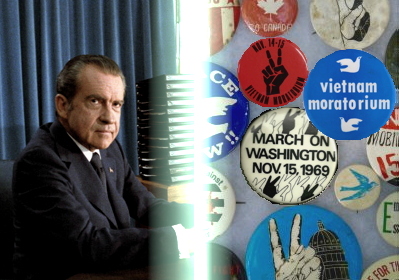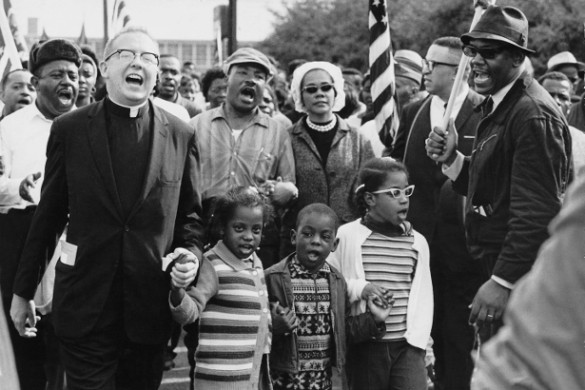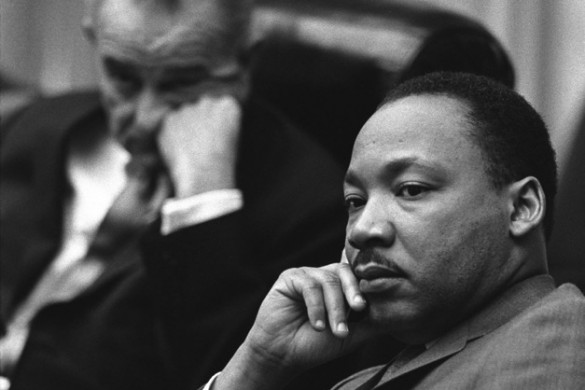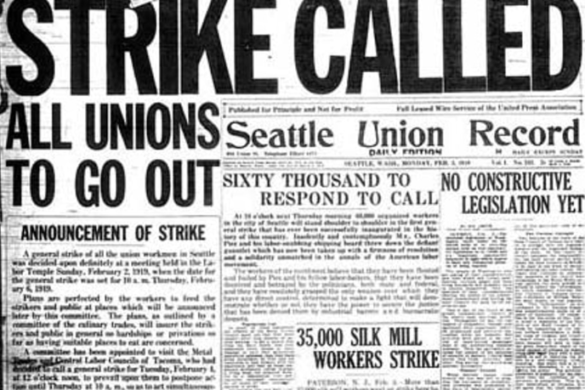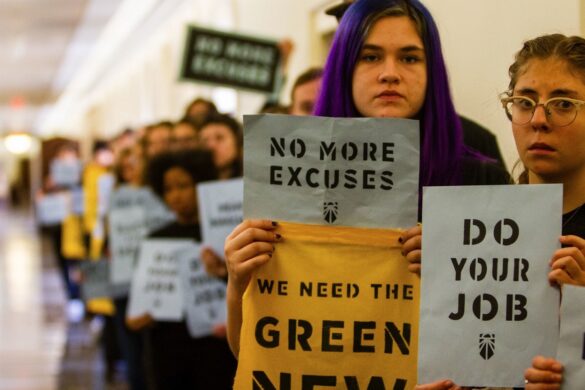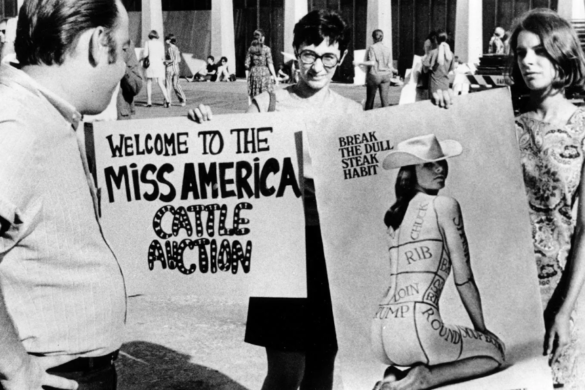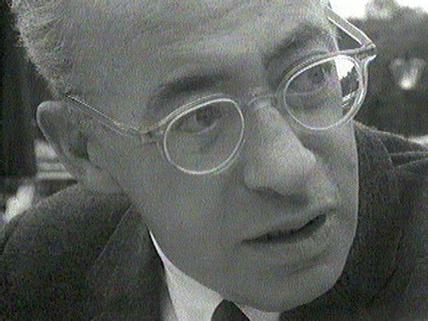As the “co-governance” model gains traction, here’s a look into the promises and pitfalls–and how organizers are reimagining electoral politics.
[Editor’s note: This article is the second in a series on the idea of co-governance. The first part looked at the history of the term and why co-governance has emerged as an important topic of social movement discussion in the current political moment. This second part examines the actual practices that make up co-governance, as well as common tensions that arise between movements and the elected officials they put into office. These articles are included in a July 2022 report, A Guide to Co-Governance: Can Movements and Politicians Work Together?]
By Mark and Paul Engler
(Published in In These Times)
The past decade has marked an era of mass protest. From Occupy Wall Street to the Movement for Black Lives, from #MeToo to the anti-Trump resistance, from pro-immigrant marches to mobilizations around climate change—some of the largest protests in American history have helped transform public consciousness and placed issues of injustice on the public agenda. Yet they have not always translated into meaningful change at the level of legislation and public policy. Lawmakers in Washington, D.C., city halls and state legislatures around the country are slow to act on movement demands, and the support of even ostensibly sympathetic politicians has often amounted to little more than rhetoric.
Recognizing that they need champions in government, social movements have responded by taking an increasing interest in electoral politics. Today, the dividends of this investment are starting to show: community activists have taken seats on city councils, progressive district attorneys have unseated “law-and-order” incumbents, and left-wing members of the Squad have joined the U.S. Congress. But even as movement champions take office, grassroots groups are facing a sobering realization: Sometimes winning an election is only a start. Figuring out what to do next is something movements have not adequately planned for.
To address this challenge, an increasing number of organizers and movement groups have promoted the idea of “co-governance.” Once an obscure concept rarely mentioned outside of academic circles, the term is taking on a fresh life and meaning in U.S. politics as grassroots organizations employ it to describe a radically reimagined model of partnership between movements and politicians.
Sometimes used alongside other terms such as “movement governance,” “collaborative governance,” or “inside-outside politics,” co-governance refers to a set of practices through which social movements and elected officials can coordinate and strategize together on the exercise of state power.
Lizeth Chacon, Founding Executive Director at Colorado People’s Alliance and board president of People’s Action—a leading network of community groups promoting the concept of co-governance—argues that under this model: “Elected officials need to treat us not as votes to be won but as partners in governance, beginning on—or long before—the campaign trail.” Or as Way to Win, a group created to organize donors to support progressive efforts, put it: “Co-governance is deep representation, it is what democracy should look like.”
Answering the call by movements, elected officials from Minneapolis to Philadelphia to New York City and beyond have embraced the concept. Jillian Johnson, Mayor Pro Tem for Durham, North Carolina and a longtime community organizer, recently told The Forge, “I have tried to put my philosophical commitment to co-governance into practice as much as possible with groups that share my values and share my goals.” And progressive Denver City Councilmember Candi CdeBaca declared on the campaign trail, “I am running because I believe we can rise together through responsible growth, people-centered transportation, and co-governance of our city.”
With the concept gaining traction, organizers are beginning to take stock of what it means in practice: What are the mechanisms of co-governance, and what are its pitfalls? A review of how movement groups across the country are applying the framework shows that, while co-governance is still being tested, its advocates have made significant advances by asking critical questions about electoral strategy—and working to formulate a better approach for how to partner with their champions in office.
* * * * *
Monolithic politicians and collective action
Co-governance starts by rejecting the idea that we can merely elect good people to office and trust them to do the right thing. The standard view of politics presented in the American media (and widely accepted by the public) looks at elected officials through a fundamentally individualistic lens. It views politicians as wielders of monolithic power, decisive players whose personal judgements, skills, and values shape public affairs. It focuses very little on how our economic system and the influence of monied interests profoundly limits those who seek to create change from inside the system. This monolithic outlook, with its emphasis on sole actors, stands at odds with the core tenets of movement organizing, which emphasize the collective marshaling of social power to transform society.
From Jesse Jackson’s Rainbow Coalition in the 1980s to the Bernie Sanders slogan of “Not Me, Us” in 2020, American politics has occasionally witnessed attempts to reinvent campaigns on social movement terms. Yet, by and large, even candidates with strong organizing backgrounds default to mainstream narratives of the public servant as heroic individual.
Grassroots groups can inadvertently reinforce this tendency towards individualism. After elections, movements tend to leave politicians to their own devices for extended periods, approaching them only for occasional asks on specific issues. This dynamic generally lasts until an officeholder makes a statement or casts a vote that disappoints, at which time activists rebuke the offending official with protests or call-outs. As People’s Action explained in the group’s 2020 platform, “Too often… we throw in to help get good candidates elected, but then leave it up to them to govern. We are supposed to ‘wait and see’ how they do, while they try to navigate pressure from other elected officials and big money on their own. This usually doesn’t end well.”
When organizations do engage with politicians, their interactions tend to be transactional: movements make a narrow demand, which politicians may or may not try to grant. Win or lose, the long-term result is the same: politicians come to look at movements as one interest group among many to appease.
Finally, the nature of U.S. political parties further reinforces the problem. In many other countries, parties typically have stronger ideological identities, representatives are beholden to the platforms of those they join, and party leadership has greater power to discipline representatives who break ranks. In contrast, in the United States, party platforms are generally regarded as irrelevant formalities. To run a campaign, candidates rely less on party structures than on their own public standing, individual relationships, and personal capacity to raise money. As a result, elected officials commonly vote in defiance of party leadership, and mechanisms to hold wayward members accountable are slim. This state of affairs can be seen most recently in the refusal of Democratic Sens. Joe Manchin and Kyrsten Sinema to back President Biden’s Build Back Better legislation, which has the overwhelming support of the party’s caucus.
How, then, can social movements combat these tendencies? Grassroots groups, which are a step removed from formal political parties, have even fewer means to make sure that the politicians they elect stay true to their principles once in office. In fact, these groups have long watched erstwhile political allies bow to personal ambition and opportunism, abandoning their movement commitments in pursuit of higher office.
Socialist organizations in the Trotskyist tradition have one solution to this problem: holding any member they elect accountable to “democratic centralism.” Under this Leninist organizational principle, members within a group debate political issues internally, but they are compelled to defend a party line publicly once an internal decision has been made. An elected official who is a loyal member of such a party would submit to decisions made by the organization’s leadership.
Having narrowly fought off a bitter recall effort in late 2021, Seattle City Council member Kshama Sawant, a member of Socialist Alternative, is likely the only elected official in the United States operating under such a structure. Indeed, despite the fact that Sawant has always been outspoken about her beliefs and affiliations, political opponents decry the idea that an outside political organization might be deliberating over her votes and making decisions in line with an ideological agenda. Likewise, these critics are aghast that Socialist Alternative members refer to Sawant’s seat as “our Council office.” Such notions fly in the face of cherished ideals of hyper-individualism.
Whether or not democratic centralism represents a desirable model, it is not a practical one for the vast majority of the existing U.S. Left, given that most social movements are made up of messy and ideologically diverse coalitions rather than a single entity under tightly centralized control. Therefore, these movements must find other means of forging durable relationships and fostering coordination with the representatives they elect.
This is where co-governance comes in. The idea is to amass a set of practices that turn the exercise of governance into a movement task, where inside and outside organizing are linked, and where the politician is but one part of a collective project to deploy social power. As Maurice Mitchell, National Director of the Working Families Party, recently argued, “Individuals, even the best individuals, don’t individually have the power to undo a system. We should anticipate that the best amongst us will encounter these really tough contradictions, and it’s our duty to make sure that they’re engaged in these contradictions with us as comrades, not alone, because no one person can transform a system.”
Mitchell adds, “To me, it’s about flipping what has been a very personal, careerist focus to something that is very much rooted and accountable to people.”
Co-governance often serves as an ideal of what the relationship between movements and their elected champions should look like. But using the concept as a model for action, rather than an abstract principle, requires looking at the mechanisms organizers have already been putting into place—and examining what is working and what’s not. As David Hatch, former director of Reclaim Chicago and founder of The People’s Lobby, argues, “What must be figured out for co-governing to flourish is for the community, [movement] leaders, and our electeds to fashion clear parameters, bottom lines, and processes that guide us in making these difficult judgments together.” In our appraisal of the framework, we have identified five practices of particular interest that give substance to co-governance as it is currently developing, as well as five common problems for movements attempting to execute this strategy.
* * * * *
Five key practices of co-governance
Let’s start with the five core elements of co-governance that movements have put into practice. These are: defining the participants involved in co-governing; establishing expectations for new officials; providing support and staffing; holding regular meetings for strategic coordination; and exploring shared governance through task forces and assemblies.
—Setting the table
A first mechanism of co-governance may seem straightforward in principle, but it can be complicated in practice: Movements determine whom elected officials will co-govern with, and what groups the politician will be primarily accountable to.
“The core of leftist co-governance is a coalition of social movement organizations,” argues political analyst Vanessa Quintana in a paper for the Goldman School of Public Policy at U.C. Berkeley. In traditional electoral politics, progressive groups act alone. They form individual relationships with public officials and lobby them on their core issues. Elected officials, in turn, work to appease individual groups by meeting specific transactional requests. Divided in this way, movement groups can easily be played off of one another. In contrast, co-governance encourages a more ideological and multi-issue approach, bringing a range of voices into shared strategic discussion. This is both a strength and a challenge.
Advocates of co-governance typically form a coalition, or “table,” of participants. Hatch explains, “By ‘table’ I mean a place where people come together with the elected or electeds who are really down with figuring out some common sort of analysis and agenda.” He adds that differently sized groups are appropriate for various conversations: “Usually there are concentric circles of folks figuring out how they’re going to organize all the other people on the inside and outside into this.” At the center is a relatively small group, usually “heads of organizations and key leaders, along with electeds and their staff.”
At times, an existing structure can give shape to a coalition. In 2019, the Working Families Party used its own ballot line to successfully run movement candidate Kendra Brooks for Philadelphia City Council. Since the party counts many prominent unions and community groups as members, its already-established leadership committees created a framework for cooperation when she won. Arielle Klagsbrun, a community organizer who managed Brooks’ campaign, explains: “Because she is a Working Families Party candidate, Kendra has something clear she is a part of and can be accountable to. She can see herself as a party-builder in a way that other movement electeds can’t, since they’re not building the Democratic Party and their role in building other movement organizations can be a little more nebulous. It puts her in relationship with movement groups in a very structured way.”
Beyond the foundation provided by the Working Families Party, Brooks had been a key organizer in the formation of the Alliance for a Just Philadelphia, a wider coalition set up the year before the election. In terms of co-governance, Klagsbrun says, “I think members of the Alliance specifically chose Kendra to be in ongoing relationship with, because it was like, we don’t actually know how to do this. This is very new. And so we should do it with somebody that came out of this space. And since Kendra was one of the founders of the Alliance, she is someone we can experiment with together.”
Movement interactions with Brooks, who had been an organizer herself, contrasted with the experience of groups trying to coordinate with another official governing from the left: Philadelphia District Attorney Larry Krasner. Arguably the most progressive DA in the country, Krasner was elected in 2017 on an anti-incarceration platform with strong support from community groups such as Reclaim Philadelphia. But while he was connected to the progressive community, Krasner’s role in relation to social movements was different. “He was our lawyer,” explains Klagsbrun. “He was the guy who got us out of jail. But he wasn’t organizing the actions.” Moreover, because he ran as a Democrat, and because he was pursuing a citywide office that required a larger number of votes to win, Krasner had to interact with a more diverse base after he took office.
Although grassroots groups set up a coalition they referred to as a co-governance table to meet and coordinate with the DA and his staff, the relationship was often tense, and the table ultimately dissolved after Krasner’s first years in office. Dialogue between movement advocates and Krasner continues, but now in a more fragmented manner, with groups that are working on distinct issues meeting separately with the relevant branches of the DA’s office.
–Common agenda, common expectations
A second vital practice of co-governance is setting clear expectations for elected officials up front, having them commit to the idea of collective strategizing before being elected.
Getting substantive buy-in is easiest with candidates who come from the ranks of movement organizations. As Chacon of Colorado People’s Alliance argues, “The most trustworthy candidates are those with a history of working for justice before they even thought about running for office, so training our community’s strongest leaders to become candidates is a must.” But even when candidates come from outside of movements, groups can nevertheless be proactive in setting expectations. “We ask candidates to endorse our agenda before we endorse them,” says outgoing People’s Action director George Goehl. “They also commit to co-governance in the endorsement process. That is key.”
Trainings are another important tool that not only help in setting expectations, but in creating greater alignment around political analysis as well. As Goehl told The Nation in 2018, “Reclaim Chicago has run multiple elected officials through a political-education training program that’s really a dissection of the last 40 years of neoliberal policy and strategy. We do that because progressives who get elected and go into the halls of power quickly realize that neoliberalism is the baseline, the dominant politic. Quickly, their radical imagination starts to fade.” Trainings help to combat that tendency, and to strengthen politicians’ ties to movement groups. “We’ve done it for our members,” Goehl explained, “so why not for elected officials?”
–Support and staffing
Once movement candidates are elected, a third key function of co-governance is providing support and staffing. Activists are trained to think that they must antagonistically push elected officials to get anything they want. But sometimes, a different dynamic comes into play when grassroots candidates take office. “Our movement politicians, we’re often not giving them enough to do,” says longtime community organizer and former ACORN leader Jeff Ordower. In his experience, sympathetic elected officials have complained that while corporate lobbyists flood them with requests about development projects and business priorities—demanding attention and claiming time—these politicians can go long stretches without grassroots groups reaching out to them about anything, contributing to the sense that they have been abandoned.
In a report-back from a 2020 retreat with several dozen organizers, elected officials, and government staffers from throughout its network, People’s Action highlighted a key takeaway: “Movement Elected officials need a lot of support, especially when they come from directly impacted communities.” The report continued: “We ask them to run and then throw them into very complicated systems without preparation and support. Most organizations are not funded to provide this kind of support and planning.”
Ordower points out that, while corporate lobbyists are adept at providing politicians with a path of least resistance—providing pre-drafted legislation and helping usher bills to completion—activists often come only with demands, which invariably create more work for overburdened representatives. “I think folks don’t understand what the other side is like,” Ordower says. “They have a strategy at each point in the process to make the politicians’ lives easier.”
Whether through research, monitoring items on the legislative agenda, or providing advice on issues that may be outside the officials’ expertise, movement groups can work to address this gap—although this takes an investment of resources and training. “Almost none of the electeds have the capacity to really research and develop policy on their own,” says David Hatch. “They need us for that.” Groups such the State Innovation Exchange (SiX) and Local Progress work to provide policy briefs, model legislation, and other support to progressive elected officials. Co-governing coalitions can help these officials to take advantage of such resources and adapt proposals to local circumstances.
One key question for movements is whether they should send organizers from their own groups to staff the offices of new officials. “I think movement governance needs to move beyond just the relationship with the elected, but also look at all the people who work for them,” says Bahieh Hartshorn, an organizer who has held positions with People’s Action and TakeAction Minnesota, a progressive grassroots group. “It’s about, who are the people that are scheduling their calendar? Who’s determining who they spend the most time with?”
To this end, some organizations have invested in creating a pipeline for political staff, just as they have tried to develop a bench of prospective candidates. Short of directly providing staffers, grassroots groups can make sure they serve on a candidate’s transition team, helping to determine who will receive appointments or fill administrative posts.
At times, organizers hired by new elected officials can reimagine the function of a politician’s office, turning it into a vehicle for base-building. As Sumathy Kumar, a co-chair of the New York City chapter of the Democratic Socialists of America (DSA), told Convergence, “all the elected officials have home offices in their districts, and these are usually used to provide services for constituents. One thing we are talking about is how to move that from direct service to organizing, so that the district office is playing a role in organizing the base.”
–Regular meetings and spaces to strategize
After helping win six seats for members in the New York State Legislature in 2020, DSA formed a “Socialists in Office Committee” to provide a space for the elected officials and the organization’s leadership to plan together. In 2021, the committee held monthly in-person meetings, in addition to twice-per-year retreats. “We’ve now created a decision-making process and in the last year we’ve gotten to a place where everyone’s committed to making decisions collectively, which is really cool,” Kumar stated.
Meetings like these make up a fourth key practice of co-governance. Whether they take place weekly, monthly, or quarterly, coordination meetings create what New York Working Families Party leaders Sochie Nnaemeka and Nina Luo call “spaces of shared strategy,” where “legislators and movement allies [can] actually strategize and organize—discuss tactics, take assignments, and share concerns and information transparently.” Beyond allowing co-governing groups and politicians to interact, regular strategy sessions can give elected officials a sense of having a political “home” that provides an anchor apart from their individual ambitions. With regard to DSA’s experience in New York, Kumar explains, “because there are six of them, they can sort of hold each other accountable. ‘We’re a crew.’ That helps people stay grounded.”
Strategy meetings with multiple officials can contribute to creating caucuses with teeth at the city and state levels—and potentially even in Washington, D.C. “I’m sure there’s more co-governance happening at local levels, but at the federal level it’s progressed a lot, and really fast this year,” says Leah Hunt-Hendrix, co-founder of Way to Win. The Congressional Progressive Caucus—which has grown to encompass more than 40% of the Democrats in the U.S. House of Representatives—has taken steps to refashion itself as a more disciplined and formidable voting bloc. In the fall of 2020, the body adopted new rules that streamline its leadership structure, mandate greater participation in group meetings, and bind representatives—with limited exceptions—to vote as a bloc if a position is supported by at least two-thirds of its members. Hunt-Hendrix notes, “The Congressional Progressive Caucus Center now holds a movement table that started meeting regularly on inside-outside strategy.” Such developments open channels for joint action, and the hope is that they will create possibilities for more robust co-governance in the future.
–Task forces and assemblies
As a final significant step toward giving concrete meaning to co-governance, advocates have pushed to open up democratic decision-making through the use of task forces, review boards, and popular assemblies. In places such as Oakland, California and Durham, North Carolina, for example, such task forces have allowed movement leaders and members of directly affected communities to have a say in shaping local plans around public safety and policing. As People’s Action contends, “We want working people involved not only in making the laws, but in implementing and enforcing them as well through oversight boards, co-enforcement of workplace standards, and other measures.”
Others, taking a cue from the example of Porto Alegre, Brazil, are calling for mechanisms that allow ordinary citizens to join directly in decision-making processes. As political analyst Quintana argues with regard to co-governance, “This framework is best coupled with elements of a participatory democracy, such as participatory budgeting and community-driven city planning.” Recent examples include the use of public participatory budgeting in St. Louis, Missouri to distribute some $80 million in funds from the American Rescue Plan Act during the pandemic, as well as people’s assemblies which helped determine the 20-year city plan for Jackson, Mississippi—both examples made possible by the election of movement-aligned officials, namely St. Louis Mayor Tishuara Jones and Jackson Mayor Chokwe Antar Lumumba. People’s Advocacy Institute executive director Rukia Lumumba recently argued in The Forge that such initiatives represent “structures that allow whole communities to be a part of the process,” and help “to envision what it means to not just have representation in government but actually have government that’s coming from the people.”
If invested with real power, task forces and assemblies can each be mechanisms of expanded democratic rule. Of course, that’s a big “if.” Lacking sufficient authority, such bodies can just as easily become excuses for delay and inaction. As the old joke goes: if you don’t want anything to get done, form a committee.
* * * * *
Five problems of political partnership
Along with common practices, the process of co-governance in the United States also comes with challenges. Identifying these pitfalls can be a step toward finding ways to collectively address them. Five of these common problems include: difficulties getting to scale; lack of buy-in from elected officials; the loss of movement leadership to electoral politics; splintering coalitions; and the tendency to revert to an adversarial relationship, rather than one characterized by reciprocity.
–Getting to scale
A first problem confronting co-governance is that of scale: It remains an open question as to whether the model can become something more than partnerships with a few diehard “movement candidates” in favorable localities. Co-governance tends to work best with tightly aligned politicians who rise from a movement’s structures. These individuals are rare, however, and they are most easily seated in posts where activist field campaigns can mobilize enough votes to provide the required margin of victory. These factors threaten to confine co-governance to the level of city council members, school board officials, and state representatives—with the addition of an occasional mayor or district attorney.
When it comes to most city-wide or state-wide offices, movements do not have the power to sway a large enough bloc of the electorate to decide the race themselves. Therefore, politicians must seek support from a diverse range of actors that goes well beyond a single group or activist coalition. This diminishes the influence that movements have over governance. With regard to Philadelphia District Attorney Larry Krasner, Color of Change criminal justice campaign director Clarise McCants told In These Times in 2018, “Even with somebody as radical as he is, there are realities around the fact that he has a wide array of people to answer to.”
A renegade mayor or DA might alone be able to implement some changes. But lacking a larger faction, a small handful of elected champions often have more limited impact—especially if they hold legislative seats rather than executive ones. “When they’re one of sixteen on the city council, it’s much less about what they can do overnight,” Klagsbrun says. “It’s more about growing our movements and using the platform and soapbox so that we can elect more people and then someday have more of a majority to pass things.”
A political dialogue based around co-governance tends to focus on getting the most out of a movement’s strongest champions. This conversation is not necessarily geared toward creating wider alliances and building up factions large enough to realign entire political parties. In politically hostile areas, the latter task means making compromises and accepting that movements may have limited control over how an official governs. In other words, a push for co-governance may not make sense outside “deep blue” areas with strong Democratic majorities.
–Watered-down commitment from politicians
The higher the political office in question, the more fickle an office holder’s conception of co-governance is likely to be. In some places, movements have elevated co-governance as a buzzword, making it desirable for liberal politicians to express support for the strategy. But because the term is not well-defined, their commitment may be little more than lip service.
“I do think that it’s started to be watered down because of how overused it’s been,” says Hartshorn of People’s Action. “Especially in Minnesota, where it’s a continuous thing that we bring up to electeds. And I think some folks who don’t come out of the movement see co-governance as something like, ‘My door is always open’ or ‘I’m always open to input from you and from my constituents.’ But being open to a phone call or a meeting isn’t co-governance. It might be access or influence, and that is a level of power. But it’s not the same thing.”
While supportive of grassroots organizing, even some of the more progressive officials in the country may have a limited view of what co-governance entails. In recent years, Rep. Ilhan Omar (D-Minn.) has repeatedly declared her belief in the idea. Yet at times she has talked about co-governance in reference to holding town hall meetings with constituents and distributing federal funding to community projects—activities that do not represent a particularly radical conception of partnership with social movements. For his part, Larry Krasner was happy to hold a monthly meeting with activist constituents. However, his office referred to it as just that: a meeting, rather than a joint exercise of power.
“I think it’s very cooptable language,” says Leah Hunt-Hendrix. “You could see businesses starting to say, ‘oh, we’re doing co-governance,’ when what they mean is lobbying for private interests instead of movements governing for the public good. So either it needs to get really defined, or it may not be a very useful term.”
–Movements losing leadership
If co-governance does expand to a greater scale, movements will have to confront the question of whether emphasis on electoral work creates a leadership vacuum in grassroots groups. Such organizations lose much-needed talent when top volunteers become candidates or organizers move on to staff political offices. As this happens, grassroots infrastructure can erode—something that has been a major dilemma in places where social movements take over the national government, such as in Bolivia, Uruguay, and other Latin American countries.
Arielle Klagsbrun, who decided to manage a city council campaign after years of base-building work, speaks to this challenge: “I was definitely a ‘fuck elections’ person,” she says. “But I think I underestimated the soapbox that elected officials have. It can be really valuable for movement building.” At the same time, she questions whether this electoral focus comes at a cost. “I’ll say that, honestly, I have a lot of tensions with the strategy that we should just run our best organizers for office,” Klagsbrun says. “I think it decimates our movement groups. We don’t have the leadership pipelines at scale right now that when you take some of the strongest leaders out of our groups, you can find somebody else to take over that position quickly. And then these leaders are moved to a fundamentally different turf—like fighting batshit crazy Republicans in the state capital instead of building the base. I think that can be really hard.”
Speaking about the experience of People’s Action, Goehl acknowledges the impact that having top people leave an organization can have, but he believes it is worth the cost. “Yeah, it sucks, but it doesn’t suck more than losing. And I think that’s the alternative: losing more,” he says.
“It took us a while to get to the place where we said, ‘this actually makes sense,’ and we were going to be happy that some of our organizers are going to leave to go to the staff of someone we elected,” Goehl argues. “The way we look at it is that we are building the forces that it takes to win. Some of that is inside the local organization, some of it’s in the national organization, some of it’s outside. But they’re not different things. We’re building something much bigger than just our organization. So we should be high-fiving and moon-walking when one of our people gets into the right position.”
“There’s a broader question of what kind of training and recruitment apparatus you need,” Goehl adds. “I mean, some organizations are just talent mills. They find and develop talent way better than everybody else. You’ve just got to figure out how to be one of those groups.”
–Splintering coalitions
A fourth common problem in co-governance is the fracturing of coalitions. Because different constituencies have different needs, an elected official may find it easier to focus on some demands at the expense of others. At that point, activists often disagree with one another about whether to take a more antagonistic stance—at the risk of shattering the partnership.
The tension was evident in the co-governance table that met with Larry Krasner in Philadelphia, and it is amplified in the criminal justice arena elsewhere, as some abolitionists reject the concept of a “progressive DA” altogether and do not believe in collaborating with an office they ultimately believe should be eliminated. In These Times reporter Rebecca Burns has documented that some DSA chapters, “in Chicago, Silicon Valley and Lansing, Mich., for example — have even ended up censuring or breaking with the city council members they helped elect.” On a national level, the organization has had sometimes bitter debates about whether to censure or expel Rep. Jamaal Bowman (D-N.Y.), specifically for votes relating to Israel and Palestine.
In her analysis of co-governance in Denver, Vanessa Quintana expressed dissatisfaction with organized labor’s reluctance to break with transactional politics. “In any election, Denver Area Labor Federation (DALF) is a key endorsement to secure,” she writes. “Unfortunately, DALF often is short-sighted in siding with political expediency in endorsing a safe candidate, often the incumbent.” At the same time, she points to problems in more radical circles that make political negotiation and compromise difficult. “Cancel culture has compounded the fear of mistakes,” Quintana observes. As she explains, “When one inevitably has a misstep, rarely is there space held for a learning opportunity. Yet, there are ample tongues to release criticism and countless hearts growing resentment. Consequently, this translates into bitter politicking with minimal space for accountability.”
Reporting back from workshops at the 2019 People’s Action national convention, David Hatch wrote about participants who feared that elected officials brokering political deals were “selling out” the movements they came from. “Clearly, the weight of experience has led many community activists to feel ‘sold out’ when our demands get tossed out once the folks who get inside the room cut the final deal,” he wrote. “But increasingly, as we gain power and get closer to that room ourselves, we also struggle with the opposite problem: if we insist on an all-or-nothing approach that puts purity over progress, we can snatch defeat from the jaws of our hard-won victory.”
Hatch believes this conflict—pitting pragmatism versus principle—will always remain part of co-governance, for a simple reason: “the line between necessary and unacceptable compromise is never as clear as we’d like.” And as long as activists are prone to disagree about where the line should be, the threat of splintering will persist.
–Not defending movement politicians
For politicians to stay loyal, they must know that movements have their backs. And so co-governance involves a fragile reciprocity, one that can feel foreign to activists accustomed to battling exclusively from the outside. As Klagsbrun notes of the Philadelphia experience, “After Kendra [Brooks] was elected, we had to have a conversation about how do we ensure that we continue to see her as part of our movements, as opposed to treating her like any other elected—even a progressive one—that just needs to be pushed or called out. Even getting to that point was a process.”
To address this problem, in People’s Action’s 2020 report-back, the group speaks of the need to promote “collective ownership” and open new conversations about “How We Walk Together.” This involves finding processes for “healing the relationships between community, elected officials and movements—exploring where and why have we caused each other harm, and what we must do to repair that harm.”
“I think most co-governing now is just trying to do transactional a little better,” says Hatch. If true partnerships are to develop, he believes, activists must be willing to defend elected champions who take heat for pushing a movement’s agenda. As he puts it, “Politicians are like, ‘I come to this table to do all the shit you want to do. But when my ass is hanging out there, where are you? So it does have to be reciprocal.”
* * * * *
Can it work?
As co-governance moves from being a mere buzzword to a model informed by a deep body of practice, its advocates will seek ways to avoid these pitfalls. But even then, the model is unlikely to fully replace more traditional practices of lobbying and accountability. Movements may elevate some champions who agree to serve as strategic partners, but they will still have to deal with the ambitious and the opportunistic—using protest and deal-making to extract concessions from more centrist politicians, even as they take steps toward setting better expectations with potential allies. All the while, organized money will continue working as a countervailing force seeking to consolidate political power into the hands of a few.
Still, rising interest in co-governance holds out the possibility of a breakthrough in movement engagement with electoral politics. “In a different world, and in a better functioning democracy, I don’t know that co-governance would be necessary to name,” says Hunt-Hendrix. “But because our democracy is so badly functioning, it feels important to recognize movements as political actors.”
The promise of the model is that, through collective action, social movements can counter norms of monolithic individualism and deepen avenues for participation in the use of state power. While there remain reasons for skepticism about whether they will succeed, believers in co-governance are intent on bringing a more genuinely democratic form of politics into American life.
[Click here to read Part I of this series, which looks at the history of the term “co-governance” and examines why the idea has become increasingly popular among movement organizers.]
__________
Research assistance provided by Celeste Pepitone-Nahas. Photo credit: Miki Jourdan / Flickr.



